Whitepaper: Exploring Drones
How Unmanned Aircraft Could Change the Way we Live, Work, and Think about Risk
INTRODUCTION
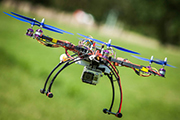 During World War II, in a top-secret mission called Operation Aphrodite, the U.S. military
endeavored to create an unmanned aerial vehicle. Early reports indicate this military
operation largely involved a B-17 bomber equipped with TV cameras, parachutes, and
explosives. The plan was for the bomber pilot to take off, reach a designated altitude, and
bail out, while a pilot in a second plane used remote controls to guide the highly explosive
plane to its target. This mission met with little success, including claiming the life of former
President John F. Kennedy’s older brother, Joseph, a U.S. Navy lieutenant whose
bomber exploded over the English Channel.
During World War II, in a top-secret mission called Operation Aphrodite, the U.S. military
endeavored to create an unmanned aerial vehicle. Early reports indicate this military
operation largely involved a B-17 bomber equipped with TV cameras, parachutes, and
explosives. The plan was for the bomber pilot to take off, reach a designated altitude, and
bail out, while a pilot in a second plane used remote controls to guide the highly explosive
plane to its target. This mission met with little success, including claiming the life of former
President John F. Kennedy’s older brother, Joseph, a U.S. Navy lieutenant whose
bomber exploded over the English Channel.
While unmanned aerial vehicles were only in their infancy during World War II, the
efforts of the “greatest generation” helped lay the groundwork for today. Drones, or
unmanned aircraft,2 have become an integral part of the U.S. military. People around the
world are buying drones online and using them to take aerial photos or videos. Businesses
are integrating drones into their long-term strategies and considering potential uses,
including the delivery of packages, spraying crops, and analyzing roof damage. Congress
and the Federal Aviation Administration (FAA) are trying to keep up with the rapidly
changing technology associated with drones and develop effective ways to regulate the
growing industry.
This white paper provides information on drones, including drone technology and design,
the potential uses for drones in various markets and industries, and ongoing federal efforts
to regulate drones. The paper also gives an overview of the potential exposures and risks that
the commercial use of drones may present to the insurance industry and global markets.
LEGISLATIVE AND REGULATORY UPDATES
In 2012, the United States Congress passed legislation that, in part, directed the FAA to
develop a plan by September 30, 2015, for “safe integration” of unmanned aircraft systems
into U.S. airspace. However, the FAA reportedly may not meet that deadline. According to
an audit performed by the U.S. government, the FAA is behind schedule, attributed generally
to both technical and regulatory challenges. FAA spokesman Les Dorr has acknowledged
the challenges that the FAA faces but has said “significant progress” has been made
toward integrating unmanned aircraft systems into U.S. airspace.3 The agency is currently
at work developing regulations, policies, and standards in anticipation of such integration.
It has been reported that the FAA expects to publish a proposed rule in 2014 for small drones
weighing less than 55 pounds that may include provisions for commercial operations of
those drones. At present, commercial operations are authorized only case by case.4
The FAA has also developed a road map that “outlines the actions and considerations
needed” to integrate drones into the National Airspace System. In the road map, the FAA
defines, in part, an unmanned aircraft as “a device used or intended to be used for flight in
the air that has no onboard pilot.” The FAA also defines an unmanned aircraft system
(UAS), in part, as “an unmanned aircraft and its associated elements related to safe operations,
which may include control stations (ground, ship, or air-based), control links, support
equipment, payloads, flight termination systems, and launch/recovery equipment.”5
In addition to the road map, the FAA recently released a number of updates in relation to
the commercial and recreational use of unmanned aircraft systems. The updates reference
the FAA’s Advisory Circular 91-57, Model Aircraft Operating Standards (AC 91-57),
released in 1981. The 1981 FAA circular provided guidance for model aircraft operators
and recommendations that, in part, stated that a model aircraft should be operated no
higher than 400 feet above ground, away from populated areas, and no closer to an airport
than three miles without prior notification to the airport’s air traffic control services.6 In
February 2014, the FAA released a statement that “[y]ou may not fly a UAS for commercial
purposes by claiming that you’re operating according to the Model Aircraft guidelines….
Commercial operations are only authorized on a case-by-case basis. A commercial
flight requires a certified aircraft, a licensed pilot and operating approval.”7 The FAA has
also indicated that “[f]lying model aircraft solely for hobby or recreational reasons does
not require FAA approval. However, hobbyists are advised to operate their aircraft in
accordance with the agency’s model aircraft guidelines.”8
In June 2014, following recent incidents involving alleged reckless use of unmanned model
aircraft near airports and over populated areas, the FAA published a Federal Register
notice of interpretation of the Special Rules for Model Aircraft as established by Congress
through the FAA Modernization and Reform Act of 2012.9 In the 2014 notice, the FAA
confirmed that the special rule generally requires model aircraft to be flown strictly for
hobby or recreational purposes and does not authorize the use of model aircrafts for commercial
purposes. Further, the notice discusses, in part, the FAA’s scope of authority to
take enforcement action against model aircraft operators who potentially may endanger
the safety of U.S. airspace as well as persons and property on the ground.10
Some examples of this interplay between the expanded uses of drones and related FAA
involvement have recently garnered attention on various fronts. The FAA fined the operator
of a small commercial drone for operating a drone while filming a commercial for a
university in 2011. However, in March 2014, an administrative law judge with the National
Transportation Safety Board (NTSB) reportedly dismissed the fine and ruled, in part,
that the FAA’s ban was not binding because it was based on a policy statement outside the
formal rule-making process. The FAA responded in a statement that it would appeal the
decision to the full NTSB. A nonprofit industry group stated that the decision “underscores
the immediate need for a regulatory framework” for small drones.
TEST SITES AND CERTIFICATE OF AUTHORIZATION
In 2013, the FAA selected six unmanned aircraft system test sites for the stated purpose
of facilitating the development of research findings and operational experiences to help
ensure the safe integration of drones into the National Airspace System. The FAA selected
test sites, in part, for their geographic and climatic diversity.12 In April 2014, the FAA
announced that the site submitted for consideration by the North Dakota Department of
Commerce was the first of the six test sites to be operational. On the day of the announcement,
the FAA granted the North Dakota agency a Certificate of Waiver or Authorization
(COA) to begin using a drone at its test site for a period of two years.13 The FAA reported
that “[w]hile the selection of these test sites will not allow immediate access to the national
airspace system for commercial and civil purposes, data and other information related to
the operation of UAS that is generated by the six test site operators will help the FAA
answer key research questions.”14
In May 2014, the FAA announced that the University of Alaska’s UAS test site was the
second test site to become operational, granting the University of Alaska Fairbanks a
COA effective for two years.15 That was followed by the announcement that the state of
Nevada, became the third operational test site upon receiving a two-year COA in June
2014.16 The other remaining test sites, which are now operational, are New York’s Griffiss
International Airport, Texas A&M University in Corpus Christi, Texas, and Virginia
Polytechnic Institute and State University in Virginia.
In a recent development, the FAA issued a COA to an energy corporation and an unmanned
aircraft systems manufacturer in Alaska for the purpose of conducting aerial surveys of
pipelines, roads, and equipment in an Alaskan oil field. This marks the first time the FAA
has authorized a commercial UAS operation over land.17
TECHNOLOGY AND DESIGN
Drone designs encompass a variety of shapes and sizes. They include fixed-wing
unmanned aircraft and helicopters referred to as “octocopters” and “quadrotors.” Some
drone designs also mimic insects and birds.
The U.S. military reportedly uses three major categories of drones: mini, tactical,
and strategic.
- A mini drone flies at low altitude for short endurance (about an hour) and at close range.
- A tactical drone flies at low-to-medium altitude for medium endurance (up to several hours) and at a range limited to line of sight (about 186 miles).
- A strategic drone flies at medium-to-high altitude for long endurance (from hours to days) and at long range.18
NAVIGATION
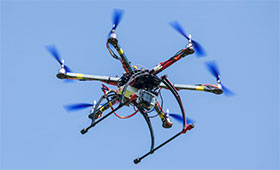 Drones currently have two basic modes of navigation. They can be controlled remotely by
a person or fly on their own using preprogrammed flight plans or more complex dynamic
automation systems.19
Drones currently have two basic modes of navigation. They can be controlled remotely by
a person or fly on their own using preprogrammed flight plans or more complex dynamic
automation systems.19
Satellite navigation and a satellite data link, in conjunction with advances in cockpit
computer automation, typically form the technological platform in drone development.
A global navigation system and a means to pilot an aircraft remotely make up the technology
that “could work on every conceivable size and type of aircraft, from a toy airplane/
helicopter to any type and size [of] military aircraft, commercial aircraft, general aviation
aircraft or even blimps.”20
Small drones known as micro air vehicles (MAVs) are becoming more advanced at navigation.
Researchers have developed an MAV that uses a camera pointed at the ground
to navigate and select landing sites, allowing it to fly without remote controls or GPS.21
According to an article, the MAV “uses the camera and onboard software to build a 3D
map of its surroundings. It can also avoid obstacles and detect surfaces above a predetermined
height as possible landing zones. Once it selects a place to put down, it maps the
site’s dimensions, moves overhead and lands.”22 In a scientific experiment, a 50-centimeter
by 50-centimeter MAV “was able to take off, travel through an obstacle-filled indoor
space and land successfully on an elevated platform.”23 Another MAV, weighing 15 grams
and measuring approximately 10 centimeters by 2.5 centimeters, is a helicopter drone
equipped with a small video camera and video downlink to relay footage in real time to
its operators.24 Dubbed “Nano UAS” by British forces, this MAV is controlled through a
tablet for surveillance purposes.
USES FOR DRONES
According to one report, spending on unmanned aerial vehicles is expected to total approximately $89 billion in the next ten years.26 The FAA currently estimates there could be as many as 7,500 small commercial drones in use in the United States by 2018,27 and companies across the country are looking at a wide range of ways to help them improve their business.
DELIVERY
A potentially widespread use of drones involves the delivery of packaged goods and other
mail. In addition to making deliveries to a specific shipping address, drones could fly to
and from designated hubs or pickup stations. For example, a retailer could use a drone to
deliver goods or documents to an assigned location where customers would receive their
packages. Such delivery reportedly may be completed in less time (and at lower cost) than
conventional means of delivery.
One online retailer has reported that it anticipates using drones to deliver packages to
customers’ doorsteps within 30 minutes, comparing their anticipated widespread use of
drones to the conventional mail delivery trucks seen on the road today.28 The delivery
range for this online retailer’s drones is currently expected to be approximately ten miles
from the distribution center.29
SURVEILLANCE
A number of industries could potentially conduct surveillance using drones outfitted with high-resolution or infrared cameras. Security personnel could use drones to monitor shopping centers and corporate offices. According to one report, drones equipped with infrared technology to record people, animals, and vehicles are being tested as a poaching deterrent to protect endangered wildlife. These test drones are reportedly capable of sending real-time digital video and thermal images from cameras to park rangers on the ground.30 Law enforcement agencies could also use drones as an aid in investigating crime, for pursuing suspects, or to protect a nation’s borders.
AGRICULTURE
In agricultural operations, drones have recently been developed that capture aerial images
to monitor crop health. The drones are able to detect pests, weeds, flooding or drought
conditions, and nitrogen deficiencies.31 A drone with data collection capabilities reportedly
can also “locate cattle and their available forage over large areas, measure crop height,
and generate topographic maps and models for land leveling and drainage applications.”32
Farmers could also use drones for crop spraying and to aid in pollination.
Drones are being considered for use in cloud seeding, which reportedly may increase precipitation
by releasing silver iodide into a storm to generate additional rain or snowfall.33
This could be beneficial in areas affected by drought or to ski resorts that rely on snowfall
for business.
DATA COLLECTION
Scientists could use drones to gather weather data, including real-time collection of
data from within hurricanes and tornadoes, helping them study and track those storms.
Graduate students at Oklahoma State University are currently designing a drone to fly
into storm systems to collect meteorological information, such as data on the formation
of tornadoes.34
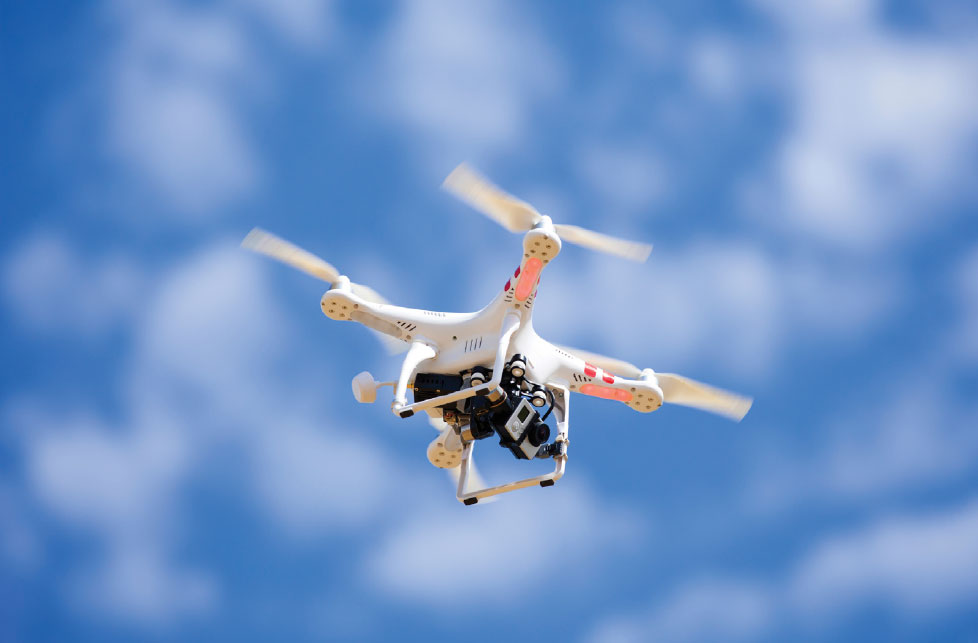
MILITARY MISSIONS AND SEARCH AND RESCUE OPERATIONS
Emergency personnel could use drones to respond to situations where people are in danger.
The drones could aid in search and rescue operations or help find missing people in locations
difficult to access. They could deliver supplies to disaster areas struck by catastrophes
such as earthquakes, hurricanes, floods, and tornadoes, and they could be used to help
fight brushfires by dispersing firefighting chemicals.
The Department of Defense (DoD) is reportedly developing concepts for drones that may
be able to deliver supplies to soldiers on the ground and conduct rescue missions. The
report estimates that combat outposts need approximately 100,000 pounds of material per
week.35 DoD representative Ashish Bagai provided the following statement in relation to this
program: “Many missions require dedicated vertical take-off and landing (VTOL) assets,
but most ground units do not have their own helicopters. Our goal is to provide flexible,
terrain-independent transportation that avoids ground-based threats, in turn supporting
expedited, cost-effective operations and improving the likelihood of mission success.”36
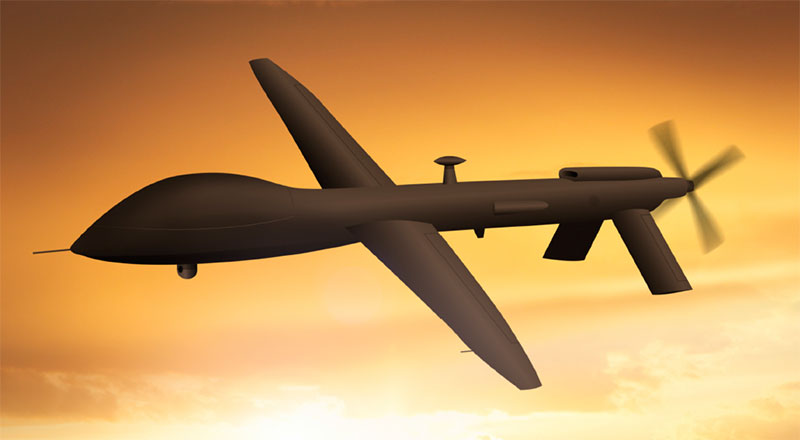
INSPECTION AND CLAIM HANDLING
The fields of structural engineering and insurance could also benefit from the use of
drones. Drones could be used to inspect roofs, bridges, and dams and survey damaged
property. They could provide information for insurers and risk managers in evaluating
The Future of Drones | 9
claims and other exposures. One property insurance defense attorney and proponent of
such drone usage stated, in part: “I envision a time when, after a catastrophe, an adjuster
pulls up to a neighborhood and opens the trunk of his car and presses a few buttons on his
tablet device and the drone does an immediate survey of everything and streams it all right
to his tablet device, and he knows exactly where to go first and what’s most significant…
within minutes. Costing very little money, the insurance company has a sense of everything
that needs to be done in a very short amount of time.”37 Municipalities could also
potentially use drones in property inspections for government tax assessment.
COMMUNICATIONS AND MEDIA
Broadcast news organizations are considering the use of drones in place of or to supplement
helicopters to obtain news footage. According to one news organization, “[d]rones
hold appeal for journalists because they would allow new perspectives and access, particularly
in areas that are not reachable by helicopter or could pose dangers to people. New
models can cost as little as $500. But regulators have to weigh free-speech considerations
against concerns for safety and invasion of privacy.”38
Drones also have many potential uses for media and advertising. Martin Scorcese used
drones to film the movie The Wolf of Wall Street, and others have used them in television
documentaries and sporting events.39 Real estate agents could use drones to take aerial
photography of properties for their listings. Wedding photographers could potentially
make use of drones to film outdoor weddings.
One drone manufacturing company reportedly is developing technology geared toward
dispersing Internet capabilities to developing regions.40 These solar-powered drones are
intended to be equipped with systems capable of communicating in an 18-mile radius.
To provide global web access at an altitude of 65,000 feet, the drones would be connected
through the Internet to build a network for data services. The drones are purportedly able
to cruise at approximately 62 miles per hour and can stay at their target altitude for five
years before needing to refuel.41
Drones could potentially be used to further education in remote areas. They could be
equipped with audio/video presentations to give lectures or deliver school supplies to
children in need.
INTERNATIONAL MARKETPLACE
Interest in drones is not only surging in the United States but is evident in Europe and
other parts of the world as well. In February 2014, the European-based organizations
Transitional Institute and Statewatch published a report discussing, in part, the European
Union’s (EU) economic and political support of the drone industry. According to the report, because of this interest from the EU countries, an EU drone policy has emerged, developed largely on the basis of two interlinking principles. The first principle appears
to arise from a need to develop and use drones all over Europe for an unlimited range
of purposes, and the second principle requires overcoming the regulatory and technical barriers inherent in drone use over EU airspace across the various member states.42 The EU is reportedly subsidizing drone manufacturers and creating what may be characterized as a favorable regulatory environment. This appears to be driven by an understanding
that Europe may be left behind in the global marketplace if it does not aggressively fund research, development, and implementation of drone technology.43 In 2012, the European Commission announced it would coordinate the use of drones into civilian airspace all over Europe.44 In June 2013, the EU published a “roadmap” for the integration of drones into commercial airspace, with an anticipated deadline of 2028.45
Australia could see more commercially operated drones in the skies because of a new
set of rules proposed by the Civil Aviation Safety Authority (CASA). Currently, there are 33 CASA-approved commercial drone operators in Australia. The approval process for those operators reportedly takes months, is costly, and requires the applicants to complete approximately 90 percent of a conventional private pilot’s training. However, the process could change if CASA introduces a new set of rules for small UAS, designed to encourage the emerging trend of drone technology and uses. The new rules reportedly would incorporate a weight class system in which CASA could clear drones weighing 2 kilograms or less for flight based on completion of an online application form.46
In China, a delivery company is testing a drone that it developed to deliver packages
over remote parts of the country. It is reported that under the current Chinese regulatory framework, commercial operators may be granted approval by the local civil aviation authorities to fly drones freely, with the exception of certain prohibited times.47 The use
of drone technology may be of interest for China in its ongoing efforts to control both pollution and traffic.
EXPOSURES
Along with the actual and potential uses for drones comes a variety of exposures that could affect several insurance lines.
Liability Exposures
Safety Issues
The potential for commercial liability exposures may be far-reaching, such as one concern relating generally to the safety of the public. Loss and damages could include bodily injury to humans and animals and property damage to buildings and personal property stemming from the use of drones. For example, a drone en route to its destination could collide with a building, a car, and/or a person, causing bodily injury and/or property damage.The Future of Drones | 10 The Future of Drones | 11 With home delivery of goods as a front-runner for the anticipated commercial usage of drone technology, some of the challenges in rolling out this technology include determining how to avoid power lines, deciphering satellite maps for optimal landing, and making sure a drone responds to unpredictable events.48 However, R. John Hansman, a professor of aeronautics at Massachusetts Institute of Technology, has generally characterized those challenges as “not insurmountable.”49
It has been reported that some farmers are currently flying their own drones ahead of the FAA’s approval of such usage.50 Farmers allegedly are using drones for crop spraying and dusting, which leads to the possibility of cross-contamination exposures. Advocates of drone use for crop spraying assert that using drones could be environmentally friendly “because we can be even more precise in how we apply fertilizer, water or pesticides.”51 However, if a drone applies pesticides on the wrong plot of land or into a water supply, the resulting contamination could prove costly and pose a threat to public health and safety. From a personal liability standpoint, homeowners who operate drones as a hobby could face bodily injury and property damage exposures similar to those of a commercial user. Further, if a child operates a drone, with or without permission, the parents could face vicarious liability or negligent entrustment/supervision claims arising from related property damage or injury to others.
Another area of concern has to do with the mechanics of the drone, including malfunctions related to a design flaw or improper manufacturing. Such defects could potentially result in products and completed operations exposures.
Privacy Issues
Risks relating to potential invasion of privacy through the use of drones have gained some media attention. Some of the concerns relate to intentional surveillance. Privacy issues may also arise with the unintended capture of images, such as homeowners’ likenesses captured in the course of inspection of a nearby construction site. Numerous organizations concerned about privacy have petitioned the FAA, citing concerns of loss of privacy for the public and generally urging the FAA to address the issues in their upcoming regulations.52Responsible Parties
The above scenarios highlight some possible general liability exposures that could arise from drone use. Inherent in those scenarios are additional questions as to who may be liable for damages should drone use result in bodily injury and/or property damage or lead to a personal injury claim, subject to any prevailing case law or legislation. For example, as one of the many possible commercial uses for drones in the farming industry, a drone could spray a field with pesticide. In that scenario, who would be at fault if the drone were to crash into a barn on a neighboring farm, damaging the building, killing the animals inside, and releasing the pesticide over the surrounding property? A claimant may sue any number of parties. If the crash were the result of negligent operation of the drone, the owner/operator might be at fault. Or if the drone crashed because of a defect or The Future of Drones | 12malfunction, the designer or manufacturer of the drone and/or the software designer or manufacturer might be responsible. If it is determined that the drone’s GPS malfunctioned and contributed to the drone veering off course, the GPS software provider might be considered a party to litigation surrounding any resulting damage. Determining the potential exposures relating to the functionality of a drone in any specific venture and its attendant risks would be one consideration in insuring this new equipment.
Property Exposures
In general, first-party commercial and personal property policies covering buildings and their contents, where applicable, address impact to such property from aircraft, vehicles, and falling objects. Some examples include the storefront damaged by a vehicle that jumps the curb or the residence demolished by a fallen two-seat plane. Another property exposure may be the potential business interruption associated with damage to a commercial building, including business income loss and other miscellaneous expenses. From a different perspective, the owner of the drone will need coverage for the drone, including its various assembled parts.53 First-party marine or hull insurance policies are among the many potential insurance products. From the personal lines perspective, the hobbyist who wishes to insure a drone may be affected by determinations relating to whether certain drones qualify as hobby aircraft. Coverage may also be required to anticipate when a drone may be exposed to theft as well as damage from collision, fire, wind/hail, and other perils.Hacking Issue
In general, drones are connected to electronic communication systems and therefore vulnerable to attack by hacking. That could possibly result in a drone’s diversion from its intended flight path, hijacking for the purpose of theft of its goods, or terrorism. Some hackers have garnered media attention with claims that they are able to compromise a drone’s security and take over its controls.54Professional Liability (E&O) Exposures
It is also plausible that the use of drones may affect the professional liability (E&O) market. The drone operator and perhaps the software developer for the drone may seek coverage for their respective operations. For example, when using drones for crop spraying, let us assume that the operator programmed the drone to spray the wrong plot of land. Such a mishap opens up arguments for a potential errors and omissions (E&O) claim. Additionally, this type of exposure could potentially relate to a multitude of activities, such as delivery, photography, and inspection.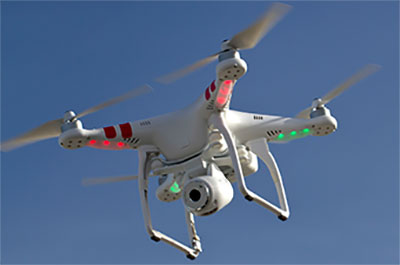
Workers Compensation and Employers Liability Exposures
Drones may replace certain job functions that humans exclusively perform, which could conceivably lead to a reduction in workers compensation and employer liability claims.Management Liability (D&O) Exposures
New technology involves new risks sometimes overlooked or not known; therefore, it is plausible to anticipate there might be increased exposure for directors and officers of enterprises that manufacture, support, or make use of drones.SOCIAL IMPACT
New technology always carries with it the potential for social impact, especially a technology
that could become a pervasive presence. With drones being proposed to deliver
packages, the traditional shipping industry may face tough challenges that include
workforce reductions.
Other sectors of the economy could face their own unique challenges as the commercial
use of drones becomes more widespread. For example, pilots who were once hired to fly
planes for crop dusting, aerial surveillance, and fighting wildfires might be in danger of
losing their jobs because drones could be used instead. In a slow economy, employers seek
ways to decrease costs, and replacing workers with technology could be part of a business
The Future of Drones | 14
strategy. In September 2013, Oxford University released a study that predicted up to
approximately 47 percent of jobs in the United States could be automated in the next
20 years, with the transportation and logistics industries being more severely impacted.55
CONCLUSION
Drones flying through our skies are no longer only in the sights of science fiction fans and visionaries. As with most technological advancements, the widespread use of drones has the potential for benefits to business, individuals, and society. Faster deliveries, better traffic reports, and more effective search and rescue operations are just a few of the ways that unmanned aircraft could improve our lives. But along with the benefits, come challenges and exposures that insurers must face. As drones become more prevalent, their use could raise questions about the safety and privacy of individuals. At the same time, they could create the potential for a range of personal and commercial liability exposures across multiple lines of insurance. There is no way to predict every function that drones will be able to perform, but one thing we can say for sure: The age of drones has only begun.
SUPPLEMENTAL SUGGESTED READING LIST
Drones
Federal Aviation Administration, Pilot Handbook (Chapter 14: Airspace), 2014https://www.faa.gov/regulations_policies/handbooks_manuals/aviation/pilot_handbook/ media/PHAK%20-%20Chapter%2014.pdf
Federal Aviation Administration, Integration of Civil Unmanned Aircraft Systems (UAS)in the National Airspace System (NAS) Roadmap, First Edition, 2013
http://www.faa.gov/about/initiatives/uas/media/UAS_Roadmap_2013.pdf
Federal Aviation Administration, Programs and Initiatives – “Unmanned Aircraft Systems (UAS),” 2014
http://www.faa.gov/about/initiatives/uas/
Federal Aviation Administration, News and Updates – “Busting Myths about the FAA and Unmanned Aircraft,” 2014
http://www.faa.gov/news/updates/?newsId=76240
References
1. http://www.defense.gov/news/newsarticle.aspx?id=441642. Unmanned aircraft are sometimes referred to as unmanned aerial vehicles and are commonly referred to as drones.
3. http://www.washingtonpost.com/world/national-security/faa-will-miss-deadline-to-integratedrones- in-us-skies-report-says/2014/06/30/fd58e8e2-007f-11e4-b8ff-89afd3fad6bd_story.html
4. http://www.faa.gov/news/updates/?newsId=76381
5. http://www.faa.gov/about/initiatives/uas/media/uas_roadmap_2013.pdf
6. http://www.faa.gov/documentlibrary/media/advisory_circular/91-57.pdf
7. http://www.faa.gov/news/updates/?newsid=76240
8. http://www.faa.gov/news/updates/?newsid=76240
9. http://www.faa.gov/news/press_releases/news_story.cfm?newsId=16474
10. http://www.faa.gov/about/initiatives/uas/media/model_aircraft_spec_rule.pdf
11. http://www.reuters.com/article/2014/03/07/us-usa-aircraft-unmanned-idUSBREA2618P20140307
12. http://www.faa.gov/news/fact_sheets/news_story.cfm?newsid=15575
13. http://www.faa.gov/news/press_releases/news_story.cfm?newsId=16154
14. http://www.faa.gov/news/fact_sheets/news_story.cfm?newsid=15575
15. http://www.faa.gov/news/press_releases/news_story.cfm?newsid=16194
16. http://www.faa.gov/news/press_releases/news_story.cfm?newsid=16334
17. http://www.faa.gov/news/press_releases/news_story.cfm?newsId=16354
18. http://www.motherjones.com/politics/2013/03/drones-explained
19. http://www.theuav.com/
20. http://www.uav-drone.net/
21. http://www.newscientist.com/article/mg21528745.000-microdrones-the-new-face-of-cuttingedge- warfare.html
22. http://www.newscientist.com/article/mg21528745.000-microdrones-the-new-face-of-cuttingedge- warfare.html
23. http://www.newscientist.com/article/mg21528745.000-microdrones-the-new-face-of-cuttingedge- warfare.html
24. http://www.theengineer.co.uk/in-depth/the-rise-of-the-micro-air-vehicle/1016519.article
25. http://www.theengineer.co.uk/in-depth/the-rise-of-the-micro-air-vehicle/1016519.article
27. http://www.newsadvance.com/news/local/judge-s-decision-sparks-buzz-over-future-use-ofdrones/ article_c2c32220-a728-11e3-8346-0017a43b2370.html
28. http://www.amazon.com/b?node=8037720011
29. http://cloudtweaks.com/2014/02/5-facts-amazons-delivery-drones/ The Future of Drones | 16
30. http://news.discovery.com/tech/robotics/drones-deployed-to-protect-endangered-animals-140122.htm
31 http://www.farmforum.net/news/farmers-learn-how-uavs-can-be-used-to-reduce-inputs/article_1c3350ff-4a06-5236-9b1d-984937401d70.html
32. http://www.prnewswire.com/news-releases/trimble-adds-unmanned-aircraft-system-to-its-agriculture-portfolio-for-aerial-imaging-and-mapping-241262291.html
33. http://www.tahoedailytribune.com/southshore/snews/9796450-113/drone-tahoe-seeding-cloud
34. http://www.tulsaworld.com/news/osu-drone-program-aims-to-unravel-weather-secrets/article_afc32b76-c875-57b1-b9bd-13482fd5ae9c.html
35. http://www.cnet.com/news/darpas-hot-for-futuristic-helicopter-like-delivery-drones/
36. http://www.darpa.mil/NewsEvents/Releases/2014/02/11.aspx
37. http://www.claimsjournal.com/news/national/2014/03/03/245393.htm
38. http://www.news-journalonline.com/article/20140211/WIRE/140219921?p=2&tc=pg
39. http://www.bloomberg.com/news/2014-02-14/illegal-drones-dare-faa-to-stop-filming-wolf-to-bulls.html
40. http://guardianlv.com/2014/03/facebook-discussing-60-million-drone-deal-to-give-global-web-access/
41. http://guardianlv.com/2014/03/facebook-discussing-60-million-drone-deal-to-give-global-web-access/
42. http://dronewars.net/2014/02/11/drones-and-the-eu-a-solution-looking-for-a-problem/
43. http://www.statewatch.org/news/2014/feb/sw-tni-eurodrones-inc-feb-2014.pdf
44. http://www.statewatch.org/news/2014/feb/sw-tni-eurodrones-inc-feb-2014.pdf
45. http://www.statewatch.org/observatories_files/drones/eu/com-2013-06-roadmap.pdf
46. http://www.abc.net.au/news/2013-03-01/drones-set-for-large-scale-commercial-take-off/4546556
47. http://qz.com/120654/china-could-become-the-first-country-to-legalize-parcel-delivery-by-drone/
48. http://www.technologyreview.com/news/522121/separating-hype-from-reality-on-amazons-drones/
49. http://www.technologyreview.com/news/522121/separating-hype-from-reality-on-amazons-drones/
50. http://motherboard.vice.com/blog/drones-will-revolutionize-farming-first-not-delivery
51. http://bigstory.ap.org/article/agriculture-most-promising-market-drones
52. http://www.wnd.com/2012/02/domestic-drones-lining-up-to-invade-privacy/
53. http://www.riskandinsurance.com/rise-drones/
54. http://www.cnbc.com/id/101464690
55. http://theweek.com/article/index/253592/why-the-us-economy-should-be-scared-of-the-amazon-drone

